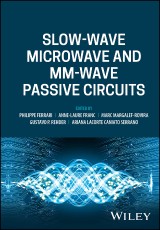Details
Slow-wave Microwave and mm-wave Passive Circuits
1. Aufl.
|
111,99 € |
|
| Verlag: | Wiley |
| Format: | |
| Veröffentl.: | 08.10.2024 |
| ISBN/EAN: | 9781119820178 |
| Sprache: | englisch |
| Anzahl Seiten: | 208 |
DRM-geschütztes eBook, Sie benötigen z.B. Adobe Digital Editions und eine Adobe ID zum Lesen.
Beschreibungen
<p><b>Comprehensive resource presenting the fundamentals and state of the art concepts, design examples, relevant components, and technology</b> <p><i>Slow-wave Microwave and mm-wave Passive Circuits</i> presents the fundamentals and state of the art concepts, design examples, relevant components, and technology of the subject, plus examples of circuit layout optimization using slow-wave circuits. Recent advances in aspects of the slow-wave concept are covered, with potential applications including automotive radars, medical and security applications, and 5G and future 6G for very high-speed communications. <p>The text considers a variety of slow-wave structures and associated concepts which are useful for circuit design, each structure electrically modeled with clear illustration. <p>The highly qualified authors show that the use of the slow-wave concept can, in some cases, improve the performance of passive circuits. The techniques proposed make it possible to reduce the size and/or the performance of the circuits, with a beneficial cost-saving effect on semiconductor materials. Concepts are applied to several technologies, namely CMOS, PCB (Printed Circuit Board) and nanowires. <p>Sample topics covered include: <ul><li>Concepts of energy storage with examples of slow-wave CPW (S-CPW), slow-wave SIW (SW-SIW), and slow-wave microstrip (S-MS),</li><li>Transmission line topology and application in integrated technologies (CMOS), including possibilities offered by the BEOL (Back-End-Of-Line),</li><li>Effect of the geometrical dimensions on the transmission line parameters (Z<sub>c</sub>, α, ε<sub>reff</sub>, and Q) and comparisons between conventional CPW and CPS, and slow-wave CPW and CPS, </li><li>Performance of slow-wave coupled lines and comparison with conventional microstrip coupled lines.</li></ul> <p><i>Slow-wave Microwave and mm-wave Passive Circuits</i> is a highly useful resource for graduate students (best complemented with a basic book on microwaves), engineers, and researchers. The text is also valuable for physicists wishing to implement comparable techniques in optics or mechanics.
<p><b>Philippe Ferrari,</b> Professor of Electrical Engineering, University Grenoble Alpes, France and senior member of the IEEE. <p><b>Anne-Laure Franc,</b> Assistant Professor with the University of Toulouse, France. <p><b>Marc Margalef-Rovira, </b>Research Engineer at STMicroelectronics, France. <p><b>Gustavo P. Rehder,</b> Associate Professor, Department of Electronic Systems at the Laboratory of Microelectronics, University of São Paulo, Brazil. <p><b>Ariana Lacorte Caniato Serrano,</b> Associate Assistant Professor of Electrical Engineering, Department of Electronic Systems, University of São Paulo, Brazil.
<p><b>Comprehensive resource presenting the fundamentals and state of the art concepts, design examples, relevant components, and technology</b> <p><i>Slow-wave Microwave and mm-wave Passive Circuits</i> presents the fundamentals and state of the art concepts, design examples, relevant components, and technology of the subject, plus examples of circuit layout optimization using slow-wave circuits. Recent advances in aspects of the slow-wave concept are covered, with potential applications including automotive radars, medical and security applications, and 5G and future 6G for very high-speed communications. <p>The text considers a variety of slow-wave structures and associated concepts which are useful for circuit design, each structure electrically modeled with clear illustration. <p>The highly qualified authors show that the use of the slow-wave concept can, in some cases, improve the performance of passive circuits. The techniques proposed make it possible to reduce the size and/or the performance of the circuits, with a beneficial cost-saving effect on semiconductor materials. Concepts are applied to several technologies, namely CMOS, PCB (Printed Circuit Board) and nanowires. <p>Sample topics covered include: <ul><li>Concepts of energy storage with examples of slow-wave CPW (S-CPW), slow-wave SIW (SW-SIW), and slow-wave microstrip (S-MS),</li><li>Transmission line topology and application in integrated technologies (CMOS), including possibilities offered by the BEOL (Back-End-Of-Line),</li><li>Effect of the geometrical dimensions on the transmission line parameters (Z<sub>c</sub>, α, ε<sub>reff</sub>, and Q) and comparisons between conventional CPW and CPS, and slow-wave CPW and CPS, </li><li>Performance of slow-wave coupled lines and comparison with conventional microstrip coupled lines.</li></ul> <p><i>Slow-wave Microwave and mm-wave Passive Circuits</i> is a highly useful resource for graduate students (best complemented with a basic book on microwaves), engineers, and researchers. The text is also valuable for physicists wishing to implement comparable techniques in optics or mechanics.



















